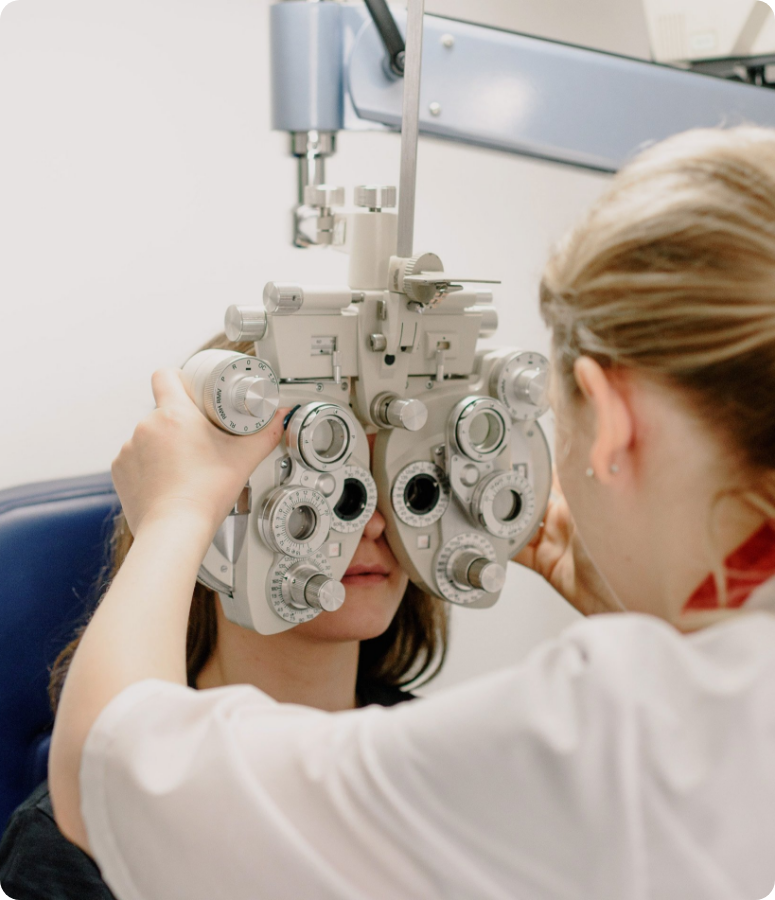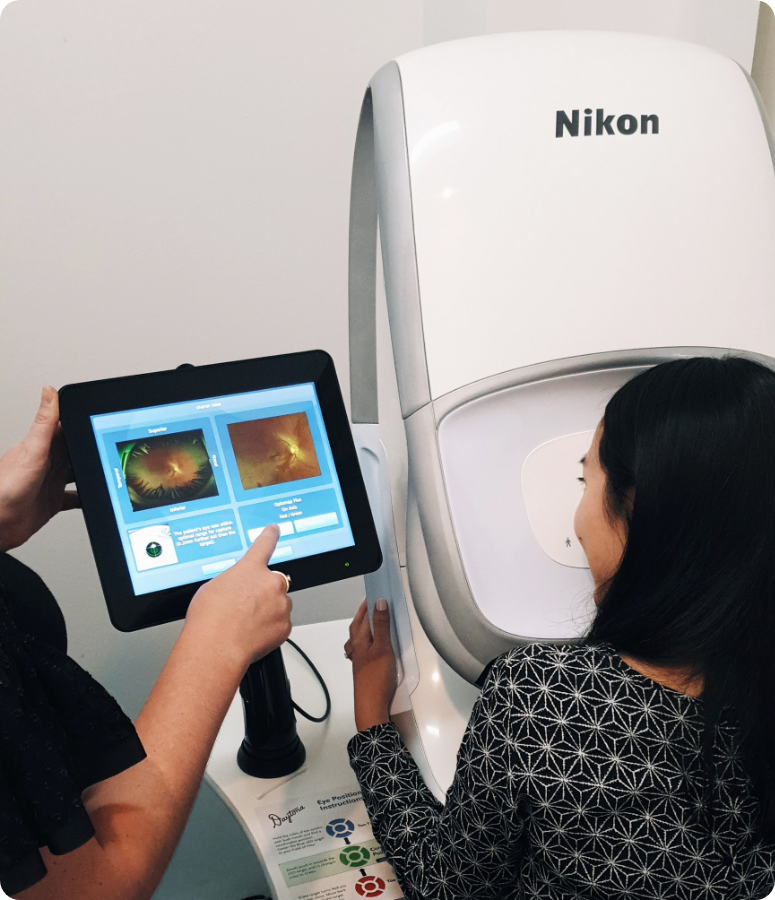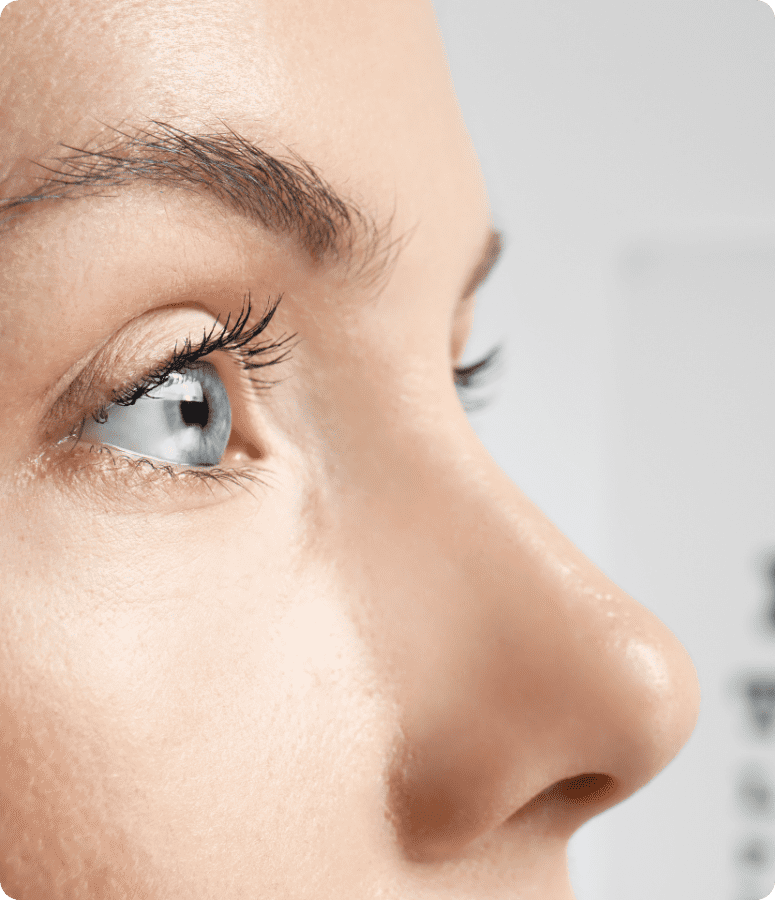Everything that relates to your eyes, explained
Your Prescription
Myopia or short-sightedness
This is when you are unable to see clearly in the distance due to the eyeball being longer than it needs to be. The most common onset is during the school years and can continue to progress until the late teens to early twenties. Vision is commonly corrected with glasses or contact lenses. The biggest concern is ensuring that the myopia does not progress too quickly. Patients with high myopia have an increased risk of associated complications, such as retinal detachment, macula degeneration and glaucoma. We offer several treatment options to help slow the progression of myopia for children and teenagers
Hyperopia or long-sightedness
Unlike its name, a long-sighted prescription is not the opposite of short-sightedness in terms of visual function. The prescription is caused by the eyeball being shorter than it needs to be. At small amounts, the focusing system is able to compensate for this and create clear vision. However, depending on its degree and the extent to which the person is able to cope with the compensation of this prescription, those with hyperopia may experience blurry distance and/or near vision, headaches, sore eyes or fatigue associated with near work. For individuals who experience symptoms associated with long-sightedness, glasses can easily correct this prescription and eliminate the symptoms.
Astigmatism
Astigmatism describes the irregular shape of the cornea (the front surface of the eye) where the shape of the cornea isn’t perfectly round like a soccer ball but more like a football. This prevents light rays from focusing on a single point on the retina, causing blurry distance and/or near vision.
Presbyopia
If you are in your mid-40’s to early 50’s, you may start finding that your arms are ‘not long enough’ or you’re needing to pull reading material further away from you to make it clear. This is the onset of presbyopia, a natural part of ageing, where there is a gradual reduction in flexibility of the lens of the eye, resulting in the eyes not being able to focus on close objects.
Accommodative dysfunction
Accommodative dysfunction is an eye-focusing problem, often due to stress placed on the visual system with prolonged near work. Some people may have difficulty efficiently sustaining focus at near, difficulty efficiently switching focus between near and far and back, or a spasm of the focusing muscle which prevents the focusing muscles from fully relaxing. Glasses are often prescribed to help support the visual system and reduce eye strain.
Diplopia
Glasses with prism lenses are used to help relieve symptoms for those with diplopia (double vision). Prism lenses bend the light before it enters the eyes to compensate for the misalignment and focus the light onto the same place on each retina. This eliminates double vision in those who wear them, creating the appearance of a single image.
Hemianopia
Hemianopia (loss of sight in visual field) most commonly occurs after a stroke and can also be due to a brain injury or tumour. People with hemianopia frequently bump into or trip over objects on the side where the visual field is missing. People with visual field loss may also have trouble reading as they will find it difficult to locate the beginning or end of sentences. Prisms cannot restore visual field loss, or fix blind spots, but spectacles with temporary prisms, stick-on prisms, or manufactured prism help to shift the image more towards their sighted area, which may assist with mobility and near tasks.


Eye Conditions
Age-related macular degeneration
Age-related macular degeneration is a degenerative condition of the macula, which is responsible for your central vision (the area that you are using to read this text or to look at objects of interest). This occurs when the cells in the retina fail to properly dispose of metabolic waste appropriately and it gets released beneath the retinal pigmented epithelium (the base layer of the retina). Depending on the stage of the disease process, there are different ways to slow down the progression of age-related macular degeneration. The earlier on in the disease the diagnosis is made, the more likely it is to slow down its progression.
Amblyopia
Also called lazy eye, amblyopia is a condition caused by abnormal development of the pathway between the eye and the brain resulting in impaired vision. Amblyopia usually develops in infancy or early childhood. In most cases, only one eye is affected but it can be present in both eyes. Over time, the brain often favours the stronger eye, and if not treated problems associated with amblyopia can become permanent. Symptoms may include an eye turn (strabismus), frequent squinting, tilting the head to see better, and poor depth perception. Treatment for amblyopia involves forcing the brain to pay attention to the images of the amblyopic or weaker eye so vision in that eye gets stronger. This can be done with glasses, eye patches, eye drops, surgery, or a combination of these.
Cataracts
As time goes on, the body adds on more layers of cells to the lens in the eye that subsequently causes the ‘clouding’ of the lens that is known as the cataract. This can cause reduced clarity of vision, which some people might describe as a ‘foggy’ view, or looking through a dirty windscreen. This is usually an age-related change, and its progression can also be accelerated by exposure to UV and certain medications such as steroids.
Colour vision deficiency
Colour vision deficiency (sometimes referred to as colour blindness) is a condition that makes it difficult to identify and distinguish certain shades of colour. This is due to a defect of the photoreceptors in the retina (called cones) responsible for processing colour. Usually, colour deficiency is inherited, however, disease, injury or exposure to toxins that damage the optic nerve or retina can also cause loss of colour recognition. Overall, more men than women affected by the condition.
The most common type of colour blindness is red-green deficiency, causing difficulty distinguishing between shades of red and green. For the rarer blue-yellow deficiency, there is difficulty identifying differences between blue and green, and some shades of yellow and violet. Often children with colour vision deficiency are unaware of their condition, however, early detection is important as many learning materials rely heavily on colour perception or colour-coding.
Diabetic retinopathy
This describes the retinal complications that can occur with diabetes. This usually involves damaged blood vessels in the eye, which can lead to haemorrhages, formation of new, leaky blood vessels or the thickening of the macula (macular oedema). This can cause reduced vision and eventually vision loss if not treated in due time. All diabetic patients (Type 1, Type 2 and gestational diabetes) are at risk of developing diabetic retinopathy. That’s why it is important to have regular eye checks if you have diabetes, particularly when you are first diagnosed and then as recommended by your optometrist. Our Optos retinal imaging and OCT technology are both extremely useful tools to monitor any retinal changes.
Glaucoma
Glaucoma is a condition that causes vision loss due to damage to the optic nerve, usually from a build-up of pressure in the eye. The most common type of glaucoma is primary open-angle glaucoma. It is often referred to as the ‘sneak thief of sight’, as there are no obvious symptoms to start and there is usually a gradual loss of peripheral (side) vision. Often a significant amount of vision loss has occurred before there is an awareness of any problem. Unfortunately, there is no cure for glaucoma and vision loss is irreversible.
Keratoconus
Keratoconus is a progressive, non-inflammatory condition of the cornea (the front surface of the eye). It is the gradual thinning of the central cornea, which subsequently leads to a developing bulge that looks like a cone. It generally starts around the mid-teenage years to early thirties and can continue to progress throughout life. There is no known cause, but there are indications that those with a family history are more likely to be affected. There has also been an association with excessive eye rubbing. Keratoconus causes blurred vision and other symptoms may include difficulty with night driving, haloes around lights, headaches or eye strain, frequent change of prescription and light sensitivity. In its early stages, glasses and soft contact lenses can help correct vision. In later stages, rigid gas permeable lenses often achieve a better visual outcome.
Strabismus
Strabismus, sometimes also known as a turned eye, is a condition that affects the muscles that control the eye’s movement causing the eyes to not look at the same place at the same time. The eye may turn in, out, up or down and may appear turned all the time or only when the person is tired or has done an extended amount of close work. When a person has strabismus, the eyes don’t focus together on the same object and each eye sends a different picture to the brain. As a result, this may create double vision or blurred vision. Over time the brain will learn to ignore the image from the turned eye. If untreated, strabismus can lead to permanently reduced vision in one eye (amblyopia). Strabismus usually develops in infants and young children, most often by age 3. Some medical conditions, brain injury or an accident can cause an adult to develop a turned eye. Treatment for strabismus may include glasses, prisms, vision therapy, or surgery.


Eye care technology
Retinal imaging
Our Optos imaging instrument captures an optomap ultra-wide digital image of your retina (back surface of the eye) using laser scanning technology. This image captures 82% of your retina including your macular, optic nerve, veins and arteries. These detailed images make it easier for our optometrists to detect any abnormalities or signs of eye disease, as well as early signs of general health issues such as diabetes or high blood pressure. Your images are stored as a reference in order to track possible eye health changes in the future.
Optical coherence tomography
Optical coherence tomography (OCT) is a non-invasive imaging scan that uses light waves to take cross-section 3D pictures of the back of the eye. These detailed scans allow your optometrist to assess the structures and layers of your retina, optic nerve and macular. An OCT scan can help our optometrists detect and monitor glaucoma, diseases of the retina such as age-related macular degeneration and diabetic eye disease.
Corneal topography
A corneal topographer maps the curvature, shape and thickness of the front surface of the eye. This provides a 3D representation of the cornea to assist in detecting and monitoring corneal irregularities and disease such as keratoconus, as well as providing valuable information for orthokeratology treatment and fitting contact lenses.
Keratography
During a dry eye assessment, we use an Oculus Keratograph 5 to take high definition diagnostic images and scans to conduct a thorough analysis of your eyes. This technology allows us to assess the quality and volume of the tears, how quickly the tears are evaporating, the thickness of the oily layer of tears, and the underlying structure of the glands that produce the oil.
Colorimetry
A colorimetry assessment uses coloured filters to help determine if specific hues can help alleviate symptoms for those suffering from visual discomfort or visual distortions. Coloured overlays or precision tinted lenses can then be prescribed once the colour and density are determined.
Visual field test
A visual field or perimetry test assesses how much you can see in your peripheral (side) vision. This test is used to detect early signs of possible glaucoma, or to help identify any vision loss or other visual field defect due to inflammation of the optic nerve, retinal degenerative diseases, brain injury, stroke, or other neurological conditions.



Ready to Book an Appointment?
Our experienced and friendly team are ready to help you, and answer any questions you might have.
Book a Consultation



